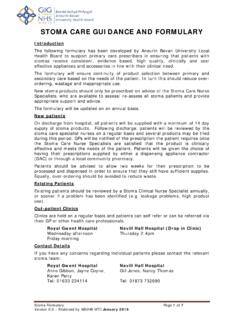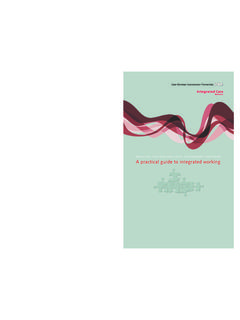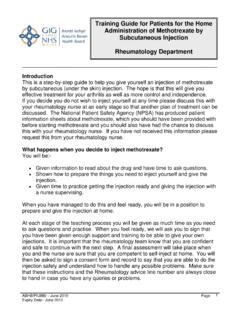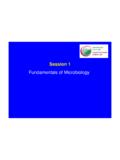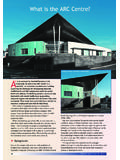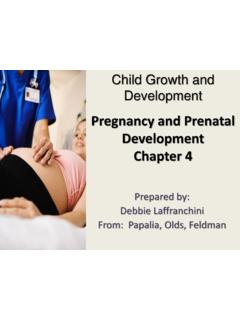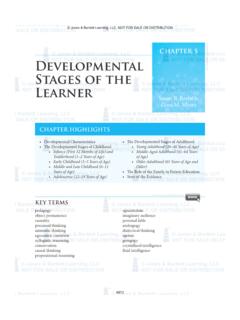Transcription of Fact sheet: UK 2 - 18 years Growth Chart
1 This Chart will most commonly be used for the assessment of individual children, rather than for population Growth monitoring purposes and includes a number of new features which can be used, when relevant, to help in the interpretation of Growth and development: Birth centiles plotting scales Scales to predict adult height and mid parental centile BMI lookup and plotting grid A new guide to assessing puberty This Chart combines data from the UK 1990 Growth reference for children at birth and from 4 -18 years1, with the WHO Growth standard for children aged 2-weeks to 4 years2. The Growth of children less than 2 years of age should be plotted on the more detailed UK-WHO 0-4 year Growth charts.
2 Measuring techniques Height Weight Remove heavy clothing and shoes and weigh using class III clinical electronic scales in the metric setting. Plotting Plot each measurement by placing a small dot where a vertical line through the child s age crosses a horizontal line through the measured value. The lettering on the charts ( weight , height etc.) sits on the 50th centile, providing orientation for ease of plotting. A correctly installed stadiometer or appropriate portable measuring device is the only equipment that can be reliably used to measure height. The measurement should be recorded to the nearest completed millimetre (first decimal place). Accurate measurement is essential and shoes must be removed for all measurements.
3 The child should stand with their heels, bottom and back of head touching the vertical measuring column, looking straight ahead, making sure the chin is not tipped up or down (see illustration of the Frankfurt plane). The height measurement is taken by lowering the measuring arm onto the child s head after asking the child to breathe in and then out and the measurement should be then read on expiration. If a child cannot stand, measure length lying down with a Dunmow measure and plot as for height (obtainable from ). Fact sheet: UK 2 - 18 years Growth Chart Birth centiles plotting scale The Chart only starts at age 2 years , so there is a plotting scale on the left of the Chart where birth weight (and length, if measured) for children born at term (after 37 completed weeks) can be plotted, to allow comparison of the birth centile with later Growth .
4 What do the centiles mean? These charts indicate a child s size compared with children of the same age and sex. The centile lines show the range of heights and weights for age and the number of children in the population expected to fall below a particular line ( 50% below the 50th, 91% below the 91st). Children come in all shapes and sizes, but 99 out of 100 children who are growing optimally will be between the two outer lines ( and centiles); half will lie between the 25th and 75th centile lines. When is a measurement abnormal? There is no single threshold below which a child s weight or height is definitely abnormal, but only 1 in 250 children are expected to have weight or height below the centile, so these children should be assessed further, if not already fully investigated when younger.
5 If weight is above 75th centile or if weight and height centiles differ, the BMI centile should be calculated (see below). If a plot falls within the shaded area on the height Chart between 8 and 13 years , pubertal assessment may be required (see below). Growth patterns before puberty Successive height measurements before puberty are highly correlated and generally between 4 and 8 years of age heights track fairly close to the same centile with only 5-10% changing by more than one centile space 3. If height measurements vary more than this it is important to check for errors either in the measuring, recording or plotting. It is known that measurements may be imprecise 4 and the need for careful accurate measuring cannot be too strongly stressed.
6 When do individual children need further assessment of Growth ? If any of the following: 1. Where weight or height or BMI is below the centile, unless already fully investigated at an earlier age. 2. If the height centile is more than 3 centile spaces below the mid-parental centile. 3. A drop in height centile position of more than 2 centile spaces, as long as measurement error has been excluded. 4. Smaller centile falls or discrepancies between child s centile and parents , if seen in combination, or if associated with possible underlying disease. 5. If there are any other concerns about the child s Growth . Adult Height Predictor Parent Height Comparator The Parent Height Comparator is on the flap to the right of the height centile Chart .
7 It is desirable and more accurate to use measured parents heights rather than reported heights. The mid-parental centile is the average adult height centile to be expected for all children of these parents. It incorporates a regression adjustment to allow for the tendency of very tall and short parents to have children with less extreme heights6. This means that children of very short or tall parents will have mid-parental centiles nearer to average than one might expect. Mark mother s height on the left hand scale and father s height on the right scale using arrows Draw a line between arrowheads and read off mid-parental centile where this crosses the central line Comparing this to the child s current height centile can help assess whether the child s Growth is proceeding as expected.
8 The larger the discrepancy between the two, the more likely it is that the child has some sort of Growth disorder. Most children s height centiles (nine out of ten) are within two centile spaces of the mid-parental centile and only one percent will be more than three centile spaces below. Most of these will have no underlying medical condition, but If there are other concerns about the child s Growth rate, a height centile well below the mid-parental centile should be investigated further. Remember also that a child growing abnormally may still be within mid parental height range, so that any child with obviously abnormal slow Growth (eg a fall of more than 2 centile spaces) should be investigated whatever their parental heights.
9 Mid parental Centile = 75thMid parental Centile = 75thThis allows you to estimate the child s adult height based on their current height, but with a regression adjustment to allow for the tendency of very tall and short children to be less extreme in height as adults5. Four children out of five will have a final adult height within 6 cm of the predicted adult height7. Use an X to mark the child s most recent height centile in the centre line Read off the child s estimated adult height from the right hand scale 80% of children will be within 6 cm of this value Scale also shown in feet and inches on left xx Body Mass Index (BMI) centile look-up and plotting grid What does a high or low BMI mean?
10 Most children will have a BMI between the 25th and 75th centiles, whatever their height centile. A BMI above the 91st centile suggests overweight. A child above the 98th centile is very overweight (clinically obese). BMI below the 2nd centile is unusual and may reflect undernutrition, but may simply reflect a small frame or low muscle mass. BMI can vary a lot over time due to measurement error. If there has been a change it is therefore important to check whether this reflects a real change in weight or inaccurate measurements. In a child over 2 years of age the BMI centile is the best indicator of thinness and fatness. The Chart below allows you to read off the BMI centile, accurate to a quarter of a centile space7.

